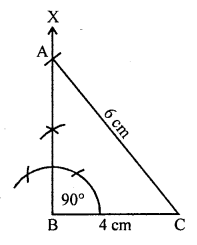ML Aggarwal Class 7 Solutions for ICSE Maths Chapter 13 Practical Geometry Ex 13
Question 1.
Draw a line, say l, take a point P outside it. Through P, draw a line parallel to l using ruler and compasses only.
Solution:
Steps of construction:
- Draw a line l and take a point P outside it.
- Take another point Q on the line l and join PQ.
- Construct at P equal to ∠PQR.
This is the required line which is parallel to l.
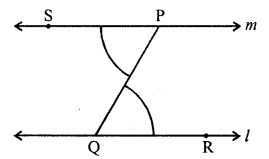
Question 2.
Draw a line l. Draw a perpendicular to l at any point on l. On this perpendicular choose a point A, 3.5 cm away from line l. Through A, draw a line m parallel to l.
Solution:
Steps of construction:
- Draw a line l and take a point P on it.
- At P draw a ray PQ making an angle of 90°.
PQ is the required perpendicular on the line l at point P.
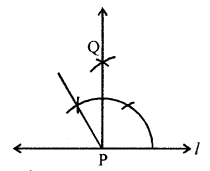
Question 3.
Let l be a line and P be a point not on l. Through P, draw a line m parallel to l. Now join P to any point Q on l. Choose any other point R on m. Through R, draw a line parallel to PQ. If this line meets l at S, then what shape do the two sets of parallel lines inclose?
Solution:
Steps of construction :
- P is a line and P is a point not on the line l.
- Take point A on it and join PA.
- On P, draw an angle equal to ∠PAl and draw a line m which is parallel to l.
- Take a point Q and join PQ. From a point R on m,
draw a line parallel to PQ which meets l at S.
We see that PQSR is a ||gm.
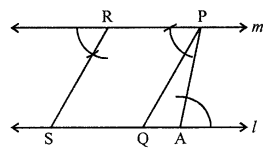
Question 4.
Construct a triangle ABC, given that
(i) AB = 5 cm, BC = 6 cm and AC = 7 cm
(ii) AB = 4.5 cm, BC = 5 cm and AC = 6 cm.
Solution:
(i) Steps of construction :
- Draw a line segment BC = 6 cm.
- With centre B and radius 5 cm and with centre C and radius 7 cm,
draw arcs which intersect each other at A. - Join AB and AC.
∆ABC is the required triangle.
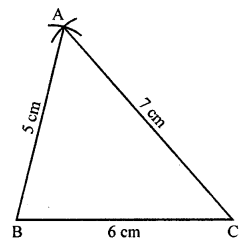
(ii) Steps of construction :
- Draw a line segment BC 5 cm.
- With centre B and radius 4.5 cm and with centre C and radius 6 cm,
draw arcs which intersect each other at A. - Join AB and AC.
∆ABC is the required triangle.
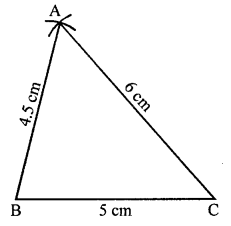
Question 5.
Construct a triangle PQR given that PQ = 5.4 cm, QR = PR = 4.7 cm. Name the triangle.
Solution:
Steps of construction :
- Draw a line segment PQ = 5.4 cm.
- With centre P and radius 4.7 cm and with centre Q and radius 4.7 cm,
draw two arcs intersecting each other at R. - Join RP and RQ.
PQR is the required triangle which is an isosceles triangle.
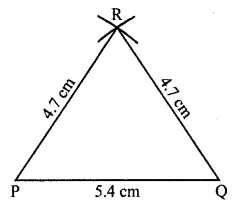
Question 6.
Construct a triangle LMN such that the length of each side is 5.3 cm. Name the triangle.
Solution:
Steps of construction :
- Draw a line segment MN = 5.4 cm.
- With centre M and N and radius 5.4 cm,
draw two arcs intersecting each other at L.
∆LMN is the required triangle which is an equilateral triangle.

Question 7.
Construct a triangle ABC such that AB = 2.5 cm, BC = 6 cm and AC = 6.5 cm. Measure ∠ABC and name the triangle.
Solution:
Steps of construction :
- Draw a line segment BC = 6 cm.
- With centre B and radius 2.5 cm and with centre C and radius 6.5 cm,
draw two arcs intersecting each other at A. - Join AB and AC.
∆ABG is the required triangle.
On measuring ∠ABC it is equal to 90°.
Therefore, ∆ABC is a right angled triangle.
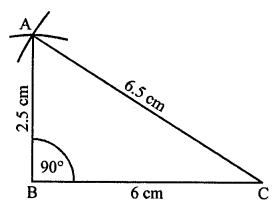
Question 8.
Construct a triangle PQR, given that PQ = 3 cm, QR = 5.5 cm and ∠PQR = 60°.
Solution:
Steps of construction :
- Draw a line segment QR = 5.5 cm.
- At B, draw a ray BX making an angle of 60°
and cut off PQ = 3 cm. - Join PR.
∆PQR is the required triangle.

Question 9.
Construct ∆DEF such that DE = 5 cm, DF = 3 cm and m∠EDF = 90°.
Solution:
Steps of construction :
- Draw a line segment DE = 5 cm.
- At D, draw a ray DX making an angle of 90°
and cut off DF = 3 cm. - Join FE.
∆DEF is the required triangle.
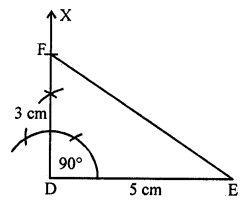
Question 10.
Construct an isosceles triangle in which the length of each of its equal sides is 6.5 cm and the angle between them is 110°. Measure base angles.
Solution:
Steps of construction:
- Draw a line segment AB = 6.5 cm.
- At A, draw a ray AX making an angle of 110° and cut off AC = 6.5 cm.
- Join BC.
∆ABC is the required triangle.
On measuring its base angles ∠B and ∠C, these are 35° each.
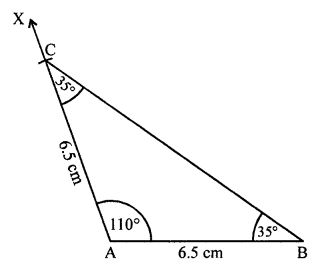
Question 11.
Construct triangle XYZ if it is given that XY = 6 cm, ∠X = 30° and ∠Y = 100°.
Solution:
Steps of construction :
- Draw a line segment XY = 6 cm.
- At X, draw a ray XA making an angle of 30° and at Y
draw a ray YB making an angle of 100°
which intersect each other at X.
∠XYZ is the required triangle.

Question 12.
Construct a triangle PQR given that PQ = 4.9 cm, ∠P = 45° and ∠Q = 60°. Measure ∠R.
Solution:
Steps of construction :
- Draw a line segment PQ = 4.9 cm.
- AP, draw a ray PX making are the angle of 45° and at Q,
draw a ray QY making an angle of 60°
which intersect it each other at R.
∆PQR is the required triangle.
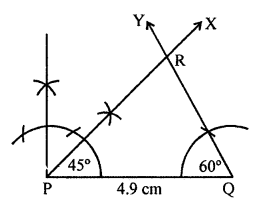
Question 13.
Construct a triangle ABC such that AB = 4.1 cm, ∠B = 90° and hypotenuse AC = 5.2 cm.
Solution:
Steps of construction:
- Draw a line segment AB = 4.1 cm.
- AB, draw a ray BX making an angle of 90°.
- With centre A and radius 5.2 cm,
draw an arc which intersects BX at C. - Join AC.
∆ABC is the required triangle.
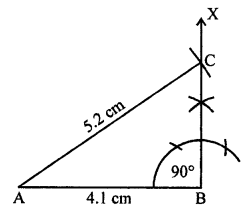
Question 14.
Construct a right-angled triangle whose hypotenuse is 6 cm long and one of the legs is 4 cm long.
Solution:
Steps of construction :
- Draw a line segment BC = 4 cm.
- At B, draw a ray BX making an angle of 90°.
- With centre C and radius 6 cm
draw an arc which intersects BX at A. - Join AC.
∆ABC is the required triangle.
